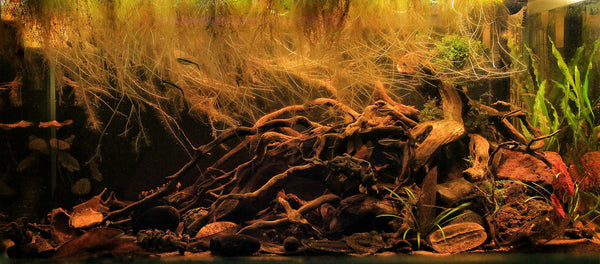- Continue Shopping
- Your Cart is Empty
Letting go...for a little while, anyways.
If you are like oh, 80% of the hobbyists out there, you tend to work pretty damn hard to make sure that you're doing all that you can for your fishes to keep them healthy and their environment stable. Of course, on occasion, life gets busy, and you might have stretches of times where you're simply not able to take care of your aquarium(s) as perfectly as possible.
Life happens.

With our botanical-focused natural aquariums, what happens when say, we skip a water exchange or two, a filter media replacement, or if we can't feed as often as we used to, or..?
Is it a big problem?
I mean, you have a tank filled with a significant amount of slowly decomposing leaves, botanicals, etc., which contribute the the bioload of the aquarium. That amount of material has to have some impact on water quality, right?
It does, but not always in the way you might think.
It's hardly scientific; it's more like a "common sense thing"- but if you're careful about how much botanical material you add in the first place, and how quickly you add it, the impact of all of this material is more of a positive, IMHO.

All additions of botanicals to an existing aquarium need to be measured, deliberate, slow, and considerate. You need to observe your fishes' reactions, monitor water chemistry, and stay alert to the changes and demands that botanicals will place on your aquarium. And they will. There's no mystery here. Adding a ton of stuff into any established aquarium creates environmental changes and impacts that cannot be ignored.
Are all of these impacts necessarily bad?
No, I don't think so.

If you think about it, these materials also function as a substrate- a "fuel", of sorts, for the growth of beneficial bacteria, biofilms, and other microorganisms within the aquarium. In my opinion and experience, when added gradually and methodically, you can look at all of this stuff as the biological "power station" for your tank, supporting a population of organisms which serve to break down more toxic compounds and substances via the nitrogen cycle.
I think it's sort of analogous to the use of live rock in a reef aquarium. Live rock is considered an essential component of a reef aquarium, because it serves as that aforementioned "biological filtration substrate" for the colonization of billions of gentrifying bacteria. This is something I'd like to see some more serious research on, because I think that there's "something" there.

So, what are the implications for us if our husbandry should slip now and then?
Will all of the botanical material continue to break down, keeping the water "tinted?" Will biofilms continue to colonize open surfaces? Will water chemistry swing wildly? Will phosphate and nitrate accumulate rapidly? Will the aquarium descend into chaos?
Or, will it simply continue to function as usual?

It's my belief that it will.
I mean, when you think about it, the natural, botanical-style blackwater aquarium is sort of set up to replicate a habitat where all of this stuff is taking place already. Leaves, seed pods, etc. are more-or-less ephemeral in nature, and are constantly breaking down in these environments. Decomposition, accumulation of epiphytic growth, and colonization of various life forms is continuous. Now, I realize that an aquarium is NOT an open system, but for the sake of this little section of the habitat- the substrate, there are many functional analogies if you study it carefully.

How much more will things change by simply delaying water exchanges for several weeks? By not siphoning detritus at all? Will this really become some sort of problem? Or, will the bacteria, fungal growths, and other microorganisms and crustacean life living in our botanical substrates continue to do what they do- break down organic waste and reproduce?
I think they will.
So...if you are in one of those "benign neglect" phases in the operational cycle of your aquarium, it's entirely possible that an established microfauna population (supported by extensive use of botanical materials) can act as a sort of "biological fail safe" for your tank. Sure, botanical-style natural aquariums are easy to maintain if you set them up and manage them correctly from the start.
Obviously, along the way, leaves and other botanical materials will impart chemical compounds, including lignin, sugars, carbohydrates, cellulose, and of course, the coveted humic substances and "tint-producing" tannins, during their submerged existence. The important thing to ponder when using leaves and botanicals is that you're likely to see an initial "burst" of the desired and less desired compounds shortly after they are submerged in the aquarium.

The extent and degree to which these compounds are imparted to the aquarium depends on numerous factors (environmental conditions, the age and condition of the leaves and botanicals, the presence of "shredders" snd "grazers" in your tank), and the extent of your preparation process. And of course, your microfauna population will adjust and grow according to the available food sources.
However, not entirely "set and forget" systems; however, they are capable of running relatively unattended- IF-you apply common sense to them. In other words, don't over-populate your tank. Don't feed excessive amounts of food. Don't forget to engage in regular maintenance (ie, those water exchanges, replacement of filter media, etc.).

Be smart.
Stay diligent. Stay inquisitive. Stay observant. Stay methodical. Stay habitual. Stay engaged...
And Stay Wet.
Scott Fellman
Tannin Aquatics






Scott Fellman
Author